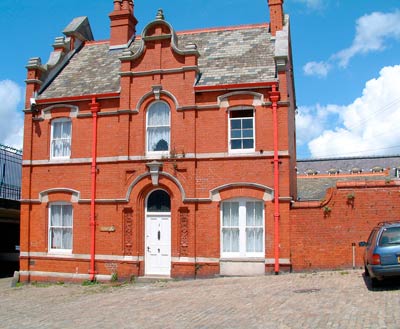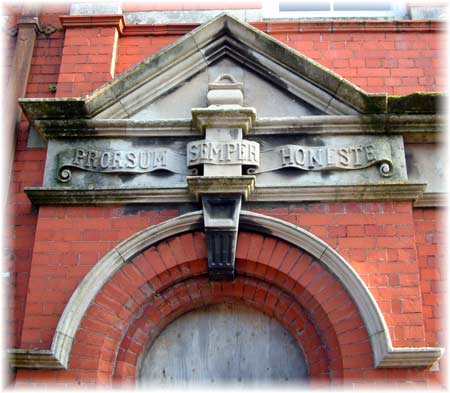The Piermaster's House

The Piermasters House, photographed by author 2004.
1899
An article in the
Western Daily Mercury
of 8 April 1899 began with the headline ...
North Corner, Devonport, A Welcome Improvement
The article continued with ...
'The Mayor (Mr W Hornbrook), formally opened the new waiting-rooms, pier master’s
residence, etc., at Northcorner yesterday afternoon. The want of warehouse and waiting-room
accommodation at this landing stage has long been felt by both traders and passengers,
and in November 1897 the Corporation obtained from the Board of Trade the necessary
powers to erect the present building. More than ordinary care has been exercised
in arranging the plan of the premises, in order to secure within a limited area
the necessary accommodation for the many and varied requirements, which include
storeyards, waiting rooms and lavatories, and a Piermasters residence and office."
Previously, North Corner had Degenerated Somewhat
During North Corner's early history the quayside and landing slips were owned by
the Lord of Manor. Leases were issued from the Manor to traders, but the traders didn't always look after
the quayside nor did they plough investment monies into it. Thus in the latter part
of the Victorian period commercial life at North Corner started to flounder. In
1870 Joseph Charles Stuart wrote to the Manor authorities stating that “trade is
entirely gone from this place”. By 1880 Devonport Corporation started
to address the issue seriously; around this time the Corporation had formed a Landing Stages Committee
and had invited Galbraith and Church, Engineers, to develop plans for new landing stages in Devonport.
Upgrade to the Quayside 1. New Landing Stage
In 1880, Galbraith and Church drew plans for two Devonport Landing
stages; one at North Corner, the other at Pottery Quay. The drawings for both are
contained in a document at Plymouth & West Devon Record Office [1]; of which the image below is the cover.

It would appear that these are the same landing stages that Brian Moseley refers to, when
he describes their completion in 1883 [2]. Moseley writes, "... on Wednesday October 10th
1883 the Mayor and the members of the Landing Stages Committee, Councillors Graves,
May, Mogg, Peck, Ryder and Whitby, met at the new North Corner Landing Stage to
receive it from the contractor, Messrs Pethick Brothers. It cost £540."
The new landing stage was officially opened on 3rd November 1883, and was operated by Mr G Hocking. Mr Hocking did have an office
on the quayside but in the event that building turned out to be temporary, lasting only until 1899.
Upgrade to the Quayside 2. Piermaster's House
As per the headlines in paragraph one above, another improvement happened to North
Corner in 1899 - the Piermaster's House was constructed. Devonport Corporation did
indeed plough efforts into North Corner since taking it over from the Manor authorities,
keeping their commitment made earlier in 1880. The Piermaster's House, as you can
see from the image, was delightful, and most importantly, it was extremely functional.
The contract was carried out by Mr H E Skinner, of the South Western Building Yard
Plymouth, from the design and under the superintendence of the Borough Surveyor
(Mr J. F. Burns) and his architectural staff. The building cost £1,492. A few yards
north of the Piermaster's House, set against the gunwharf wall, a public lavatory
was built at the same time, "constructed of brick throughout, with moulded Portland
stone dressings." The lavatories cost £198 and the contractor was a Mr S. Perkins.
Thus as well as the waiting room in the Piermaster's House, which was heated when
cold, river passengers had their personal conveniences catered for even when the waiting room was closed.
There was a large gathering at the opening ceremony, which was performed by the Mayor
in a gale of wind, with the spray from the river dashing a long
way up the quay. The company having inspected the building Mr G. Risdon (Chairman
of the Landing Stages committee) expressed his thanks to the Mayor for being present
to open the "beautiful building, which would supply a long-felt want in that part
of the Borough".
Features of the Building
The newspaper article referenced above gave this description of the property when new...
'The Piermaster’s residence, which is situate on the first floor, comprises a commodious
living-room, scullery and pantry, fitted with every convenience, and two bedrooms,
with sanitary accommodation on a separate landing. The building is of a substantial
design, and constructed of brick throughout, resting on a heavy concrete foundation,
rendered necessary by the loose nature of the ground. The outside walls are built
on the ‘ventilated cavity’ principle to ensure perfect immunity from dampness. The
exterior is faced with red Ruabon brick and terra cotta pleasantly relieved by Portland
stone, freely used in bands and moulded string courses running round the greater
portion of the work; the gables are also finished in moulded stonework, and surmounted
with shaped terminals. A stone pediment is formed over the waiting room entrance
with a carved scroll bearing the Corporation motto, “Prorsum semper honeste” in
gilt letters, whilst on either side of the south entrance doorway are specially
designed, ornamental panels in red terra cotta, built in the brickwork. The waiting
rooms, office, and residential portion are warmed by open grates and ventilated
by Boyles fresh air inlet brackets and mica-flap outlets built in the walls. The
vestibules, passage and lavatory floors are laid with encaustic tiles, and the walls
of the ladies lavatory are finished in decorated glazed tiles, the whole of the
sanitary fittings being of Twyford’s high-class manufacture.'

Above: Pediment over the waiting-room door, with Devonport motto.

Above: The side of the building facing west, to the river. Photo taken in 2000 during
the building's desolation stage. The black portion in the image is the 1963-built bridge at
North Corner, which the photographer was standing underneath.
Busy Busy Quayside
For Devonport traders, the facilities provided by the new building, and the management
of the landing stage by Captain Angear, the first Piermaster to live in the
new house, was long awaited. This was the most important landing quayside in the
town. Other Devonport landing points were located at Pottery Quay and
Mount Wise, but it was North Corner where produce from the Tamar Valley was unloaded
and taken to Devonport market; and it was from here that, historically, most of
Devonport's passenger boats came and went. The volume of produce arriving from the
Tamar Valley made North Corner the most profitable landing stage in Devonport. Within
12 months from the new facilities being built, the toll receipts, in 1900, were
more than £49, while those at Pottery Quay were just over £5 and Mutton Cove just over
£16. [2]
1950s
As a corporation office the function of Piermaster ended during the 1950s;
the last person to hold this role being Bill Jefferis. Mr Jefferis continued to live in the property for many more years
after his Piermaster employment ended.
1970s
Bill Jefferis was rehoused in nearby Cornwall Street sometime during the
early 1970s. After this the building was finally closed up, suffering severe damp. Council
committees periodically discussed the damp, and by now vandalised, building, evidenced
by articles being published in local newspapers in 1974 and 1976; they didn't know
what to do with it, whether to keep or sell it?
2000
For nearly 30 years the building lay idle, and began to rot. At times local children set
fire to it, vandals tried to break in and/or leave their piles
of rubbish around the vicinity. The building was becoming dilapidated. Eventually the council offered
it for sale and in 2000 John Hamilton purchased it for around £50,000. [3]
2005
In 2005 the Piermaster's House was offered for sale once again. John
Hamilton had converted it into five self-contained flats and four bedsits, with
a triple garage, then advertised it with Alan Cummings and Co for £375,000. [4]

Above. John Hamilton working on improving the property, in 2003, standing just inside the main front entrance.
Note the wooden pediment structure overhead, with its markings.
2012 Update
12th September - I was pleased to receive an email from the current proud owner of the property, Janet Trewin. Janet said she bought the property in
2006 for £360.000 from John Hamilton. She went on to say, "The building is currently
listed as an HMO (House of Multiple Occupancy) and is currently undergoing major
works, as requested by Plymouth City Council, i.e Fire alarm system, fire doors,
and walls, etc. It will remain in this form for a long term, as we bought it as an investment.
Love the building, had a few nightmare tenants, and hope one day to see that awful
bridge come down, so this house can once again be seen in its full glory properly
from the front."
Thank you for your email and update Janet, appreciated.
Sources:
Western Daily Mercury 8 April 1899.
[1] Galbraith and Church, Engineers. Plans of proposed Devonport landing stages at Pottery Quay and Cornwall Street/North Corner, 1881. Available at Plymouth & West Devon Record Office, Ref 302/17
[2] Brian Moseley. Landing Stages, Devonport. (http://www.plymouthdata.info/)
[3] Personal communication between author and John Hamilton, 2003. John wouldn't reveal the exact sum he paid for the building, but stated "around £50k"
[4] Sales pamphlet issued by Alan Cummings and Co. 2005
(Liz Cook. page added 9 June 2011)